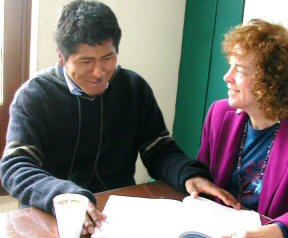Tandem Language Learning: Real Life Practice in Basic Spanish Grammar
Note: This basic Spanish grammar page is part of a series of blogs that we did while learning Spanish language in Peru. Each blog focuses on real life examples of how we crafted our foreign language course. They are designed so show you how to create your own Walkabout foreign language course. Use our examples here for any language you want to learn. See the "More Peru Stories" list of links on this page for additional language learning strategies. Also see our Learn Spanish section.
 Juan and Ann learning language together
Juan and Ann learning language togetherTerry Marshall
Want to practice basic Spanish grammar? Try tandem language learning. My tandem language learning is a voluntary one-on-one Spanish exchange between two students in basic Spanish grammar.
In my case, I am learning Spanish and my tandem is learning English. The goal is for each of us to help the other with our native language. We each create a foreign language course for the other person. The structure is left to the participating pair, with an expectation that we will share the time equitably between the two languages, and good things will follow . . .
Terry and I are delighted with how well our tandem language learning sessions are going. His tandem (or, in Spanish, tamden) is a young architect who owns her own business and is enthusiastic about learning English. Mine is a young travel agent who needs English for his work in guiding people to their hotels upon arrival in Cusco. Both caught on quickly to the importance of practical drills for learning basic Spanish grammar. They are quite the task masters. Terry’s tandem actually gives him homework. For more about Terry’s tandem language learning, please see Spanish Tutorial.
A Travel Agent Works on Needs Specific to his Work
Juan’s job plunges him into an English-fueled world, even though his agency seems to cater to German tourists. He’s the guy who holds up a sign with designated names and meets the agency’s clients at the airport. He makes sure the bags are collected, ushers travelers to their hotels, later picks them up from their lodging, and makes sure they have the proper tickets and gear for their tours. And he is preparing to be the tour guide who explains the sites his clients are seeing.
We have used his guide book to refine his spoken English. He reads the basic text for various tours his agency offers, and we work on pronunciation and intonation. We discuss words he doesn’t understand and use the text to expand his vocabulary. The added benefit is that I am learning about Peru culture and history beyond what I have been able to pick up in our own tourist outings.
Juan is extremely knowledgeable about English grammar – he can quickly name grammatical forms, such as present participles and past perfect, which most American students have forgotten by the time they graduate from high school. But pronunciation and intonation tend to be stumbling blocks. I have seen him make big strides in understanding and using words in his guidebook and in conversational English.
In return, he has given me one-on-one Spanish instruction, which has been great for my Walkabout Language Learning™ excursions--Step 4: Communicate--such as the exchange of a battery recharger we bought that didn’t work when we got it home, and various other errands. He corrects my basic Spanish grammar and is also is a patient drill master for my pronunciation.
More Peru Stories
Intensive Spanish
The Next Adventure: Create Your Own Language Learning Tandem
Every foreign language course can be enhanced by a one-on-one tutorial. I'm sure they can come in as many flavors as the mind can invent.
- A number of websites are dedicated to tandem language learning through email correspondence. They can help people connect in 100's of languages. LiveMocha, owned by Rosetta Stone, for example, allows you to select your foreign language course. They offer courses for dozens of languages. You work through lessons at your level, and submit your record your responses, then native speakers review them and provide feedback. The site is free ... sort of ... you earn points by reviewing other participants responses, then you can use your points to "buy" the next lesson. You can also purchase points if you want to speed your language learning along. You can also connect with language partners to send and receive email within LiveMocha. When we initially tried LiveMocha, we had difficulty with men who solicited us with pick-up lines like "You are very pretty" which made us wonder if the wanted something more than language learning. LiveMocha has since made that more difficult, but it is still something to be careful about.
- Several U.S. cities have initiated cross-cultural exchanges in which people of different languages and cultures are invited to come together, share experiences, and as possible, establish face-to-face relationships through which they can improve their ability in another language. We have joined such a "Meetup" group in our community.
- I have friend who teaches one-on-one Spanish by telephone to a student in the U.S. They have a two-hour conversation once a week. My friend tells me the land-line phone cost for the U.S. resident to talk for two hours is about US$5 an hour. If that is too steep for you to refine your basic Spanish grammar, you can use a voice-over-Internet-Protocol (VOIP), such as Skype, which is free. Some VOIP fans use video cameras so they can actually see one another on their computers. On the downside, you need high-speed internet, and the quality of transmission may vary. The cost of instruction is on top of the phone cost, but also quite reasonable.
- Download the Walkabout Language Learning Action Guide which will show you step by step how to set-up your own one-on-one language learning sessions.
We are thinking about working out suggestions for people who want to develop this kind of informal foreign language course. These suggestions would be for people working through an established program like the one we have at Maximo Nivel, or in more informal arrangements among people who want to improve their ability in another language by working with native speakers. Click here to learn how to get the most out of your tandem.
If you don't know a native speaker who's read to start a tandem, but you still want to get started learning a new language, try signing up with a professional language tutor.
Basic Spanish Grammar Lessons Learned
- Think outside the book in developing new language learning material relevant to your needs and to increase motivation.
- Use the skills of a native speaker who wants to learn your language to create a tandem language learning experience.
--Posted by Ann, October 20
← Previous: Typical Day Next: Changing money →
Return from Basic Spanish Grammar to Language Lore
Return to Your Language Guide home

New! Comments
Have your say about what you just read! Leave me a comment in the box below.